
The Zero Trust Maturity Model (ZTMM) outlines the stages organizations go through in adopting a Zero Trust architecture — from traditional, to advanced, to optimal maturity. Reaching optimal maturity requires continuous identity verification, granular data access controls, and activity monitoring. Zero Trust Data Access (ZTDA) is key to achieving this by extending Zero Trust to file-level interactions across a hybrid infrastructure.
The Zero Trust Maturity Model and the Role of ZTDA
Estimated reading time: 4 minutes
Table of Contents
-
-
-
-
- Introduction – How ZTDA Strengthens Your Zero Trust Maturity Model (ZTMM) Journey
- What is the Zero Trust Maturity Model (ZTMM)?
- How Zero Trust Data Access (ZTDA) Fits into the Zero Trust Maturity Model
- Strategic Benefits of Implementing ZTDA in your ZTMM
- Conclusion – Closing the Gaps in Your ZTMM with Zero Trust Data Access
-
-
-
Introduction – How ZTDA Strengthens Your Zero Trust Maturity Model (ZTMM) Journey
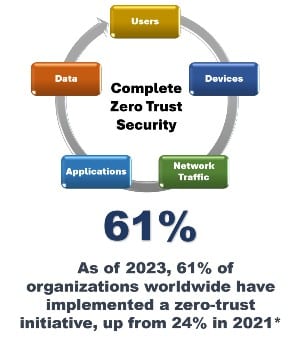
As cyber threats grow more sophisticated and distributed workforces become the norm, organizations are shifting away from traditional perimeter-based security models toward a more adaptive and resilient approach: Zero Trust. At the core of this shift is the Zero Trust Maturity Model (ZTMM) — a strategic framework designed to help enterprises assess their current security posture and build a roadmap toward full Zero Trust implementation.
Developed by cybersecurity leaders such as the U.S. Cybersecurity and Infrastructure Security Agency (CISA) and NIST, the ZTMM provides structured guidance across multiple security pillars, helping organizations understand where they stand, identify gaps, and prioritize investments.
But while identity and network security often take center stage in Zero Trust conversations, the ability to control and protect data access—regardless of where that data resides—is just as critical. This is where Zero Trust Data Access (ZTDA) becomes a foundational enabler, especially for organizations handling sensitive or regulated information.
What is the Zero Trust Maturity Model (ZTMM)?
The Zero Trust Maturity Model (ZTMM) is a framework developed by organizations like CISA and NIST to help enterprises evaluate their adoption of Zero Trust principles. It has three key stages:
– Traditional: Implicit trust, perimeter-based security.
– Advanced: Partial Zero Trust controls, siloed implementation.
– Optimal: Organization-wide Zero Trust integration with continuous validation, least privilege, and data-centric access control.
| Maturity Level | Characteristics | Role of ZTDA |
| Traditional | Perimeter-based, implicit trust | Not aligned with ZT principles |
| Advanced | Partial segmentation, basic identity controls | Optional, but helpful |
| Optimal | Continuous validation, full segmentation, least privilege | Essential for protecting data access and achieving full Zero Trust |
The model helps organizations understand where they are on their Zero Trust journey, plan investments and implementation steps, prioritize areas that need attention and mature over time from basic to advanced Zero Trust capabilities.
To achieve optimal maturity, organizations must implement Zero Trust Data Access (ZTDA) to protect unstructured data and enforce policy-based file access in real time.
Zero Trust Maturity Pillars
Zero Trust maturity is assessed across seven key pillars:
- Identity – Authentication, access control, identity governance
- Devices – Inventory, monitoring, and securing endpoints
- Network/Environment – Microsegmentation, encrypted traffic, traffic analysis
- Application Workloads – Protecting applications and the code/data they handle
- Data – Classification, encryption, access monitoring
- Visibility & Analytics – Centralized logging, SIEM integration, threat detection
- Automation & Orchestration – Automating security responses and enforcement
Each pillar has maturity indicators that define how advanced the implementation is.
How Zero Trust Data Access (ZTDA) Fits into the Zero Trust Maturity Model
Zero Trust Data Access (ZTDA) plays a critical role in advancing maturity across several pillars of the Zero Trust Maturity Model, especially the data and identity pillars. Let’s break it down:
-
Data Pillar
This is the most obvious fit.
-
-
- Traditional: Data is often widely accessible once someone is “inside” the network. Access controls are coarse (e.g., folder-level, share drives).
- Advanced: File-level access control, encryption at rest and in transit, some monitoring of data access.
- Optimal (ZTDA):
- Data is accessed just-in-time, just enough, and only by verified users on trusted devices.
- Access is governed dynamically, based on context (user, location, device posture, time, etc.).
- No data is moved — access is proxied or streamed, reducing data sprawl.
- All access is logged and auditable, enabling visibility and real-time anomaly detection.
-

-
Identity Pillar
ZTDA enforces strict access policies based on identity verification.
-
-
- Integrates with MFA, SSO, and identity governance systems.
- Enforces least privilege at the data level — not just application or system level.
- Adds contextual awareness to access decisions (user role, location, device status).
-
-
Network/Environment Pillar
ZTDA enhances this pillar by controlling data flows and enforcing access policies at the edge—without relying on traditional perimeter-based defenses. Here’s how it fits:
-
-
- Reduces lateral movement by eliminating broad network-level access and replacing it with file-level, just-in-time access.
- Minimizes reliance on VPNs, which often grant too much trust and create security blind spots.
- Integrates with microsegmentation strategies by making data available through secure proxies or streams, not open network shares.
- Protects hybrid environments (cloud + on-prem) by allowing secure access without exposing the underlying network architecture.
-
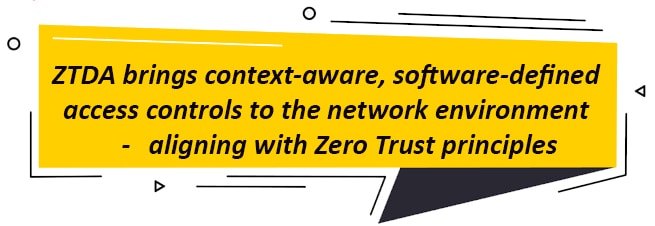
-
Visibility & Analytics Pillar
ZTDA provides deep, data-level visibility that most traditional network tools can’t reach:
-
-
- Granular logging of who accessed which files and when.
- Real-time alerting for anomalous behavior.
- Centralized audit trails feed directly into SIEMs and security dashboards for end-to-end data access visibility.
- Supports forensic investigations with clear, immutable records of access and activity.
-

Strategic Benefits of Implementing ZTDA in your ZTMM
Implementing Zero Trust Data Access (ZTDA) in a Zero Trust Maturity Model brings tangible, strategic benefits across security, compliance, operational efficiency, and business agility. Here’s a breakdown of the “why”:
| Benefit Area | What FileFlex Does | Business Outcome |
| Data Security | Enforces least-privilege, file-level access | Reduces breaches & insider threats |
| Visibility | Tracks file access | Improves incident response & compliance auditing |
| Data Control | Allows file use without downloads or replication | Reduces data sprawl and data leakage |
| Regulatory Compliance | Enables encryption, access controls, and full logging | Helps meet GDPR, HIPAA, FFIEC, GLBA, DORA, CCPA etc. |
| Hybrid Work | Direct secure access without VPNs or sync tools | Enables seamless remote collaboration |
| ZT Maturity Progress | Advances data and identity pillars | Moves orgs toward “Optimal” Zero Trust maturity |
| Efficiency | Centralizes control without re-architecting infrastructure | Reduces IT overhead |
| Agility | Easily extends secure access across the org | Enables large-scale secure collaboration |
-
Protects the Crown Jewels – the Data
Most breaches are about data exfiltration. ZTDA focuses directly on protecting what matters most.
-
-
- Access is never implicit, even after login.
- Enforces least privilege and just-in-time access.
- Prevents unauthorized data movement, even from insiders or compromised accounts.
-
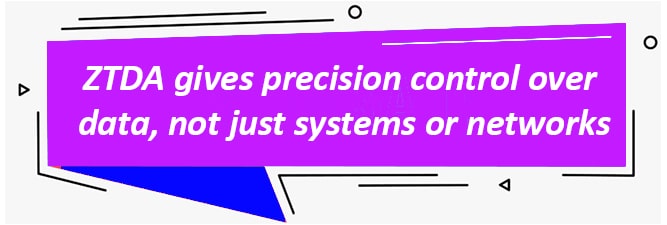
-
Provides Full Visibility and Auditing of Data Access
ZTDA creates rich, real-time audit trails of:
-
-
- Who accessed what and when, and whether the access was successful, denied, or anomalous.
-
This is invaluable for security teams, auditors, and compliance officers.
-
Minimizes Data Exposure
-
-
- Users can view or use data without downloading it.
- Sensitive files stay in place — no more duplication across email, cloud apps, or VPN shares.
- Helps prevent shadow IT, data sprawl, and data loss.
-
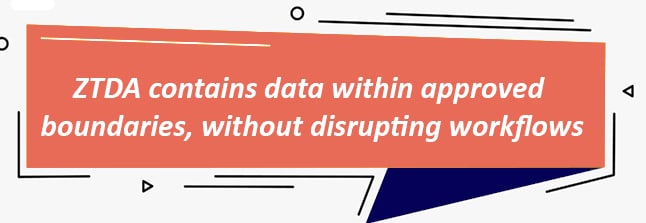
-
Accelerates Compliance with Regulations
ZTDA directly supports compliance with:
-
-
- GDPR
- HIPAA
- CMMC
- NIST
- FFIEC
- GLBA
- DORA, etc.
-
You can demonstrate:
-
-
- Controlled, policy-based access
- End-to-end encryption
- Full auditability
- Strong identity verification
-
-
Enables Secure Hybrid Work
ZTDA eliminates the need for VPNs or file replication:
-
-
- Users securely access files on-prem, in the cloud, or across geographies — without moving them.
- Ideal for remote teams, contractors, and third-party partners.
-
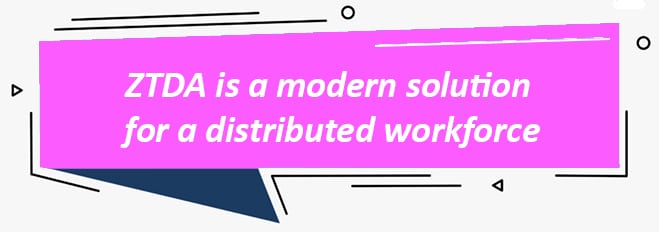
-
Supports Zero Trust Maturity Across Pillars
-
-
- Identity: Strong contextual access control
- Data: Granular, adaptive policies
- Network/Environment: Reduces lateral movement and reliance on VPNs, integrates with microsegmentation strategies, and protects hybrid environments.
- Visibility: Full logging and analytics
-
-
Provides Business Agility Without Sacrificing Security
-
-
- Onboard new users or departments without new infrastructure.
- Enable secure data sharing without creating bottlenecks.
- Extend secure access to partners, suppliers, and regulators — even if they’re outside your domain.
-

Conclusion – Closing the Gaps in Your ZTMM with Zero Trust Data Access
Incorporating Zero Trust Data Access (ZTDA) into your Zero Trust Maturity Model (ZTMM) is not just a security enhancement—it’s a strategic imperative. By extending Zero Trust principles directly to data access, organizations can safeguard their most valuable assets, reduce risk, support compliance, and enable secure collaboration across users, devices, and locations. As organizations progress from traditional to optimal maturity levels, ZTDA plays a pivotal role in bridging critical gaps across identity, data, and visibility pillars—making it a foundational element for realizing the full potential of Zero Trust.
For further reading see Using Zero Trust Data Access for NIST Compliance and Using Zero Trust Data Access to Meet the DIB Cybersecurity Strategy.
Learn More About FileFlex Sign Up for a Free TrialFrequently Asked Questions
What are the stages of the Zero Trust Maturity Model?
The Zero Trust Maturity Model includes Traditional, Advanced, and Optimal stages. Each stage reflects a deeper implementation of Zero Trust principles across identity, network, and data access layers.
What is required to reach Optimal Maturity?
Achieving Optimal Maturity requires enterprise-wide application of Zero Trust principles, including continuous verification, least-privilege access, microsegmentation, and secure data access like Zero Trust Data Access (ZTDA).
How does ZTDA support the Zero Trust Maturity Model?
ZTDA helps achieve optimal maturity by securing unstructured data across all environments, enforcing file-level access controls, and ensuring continuous authentication and monitoring.